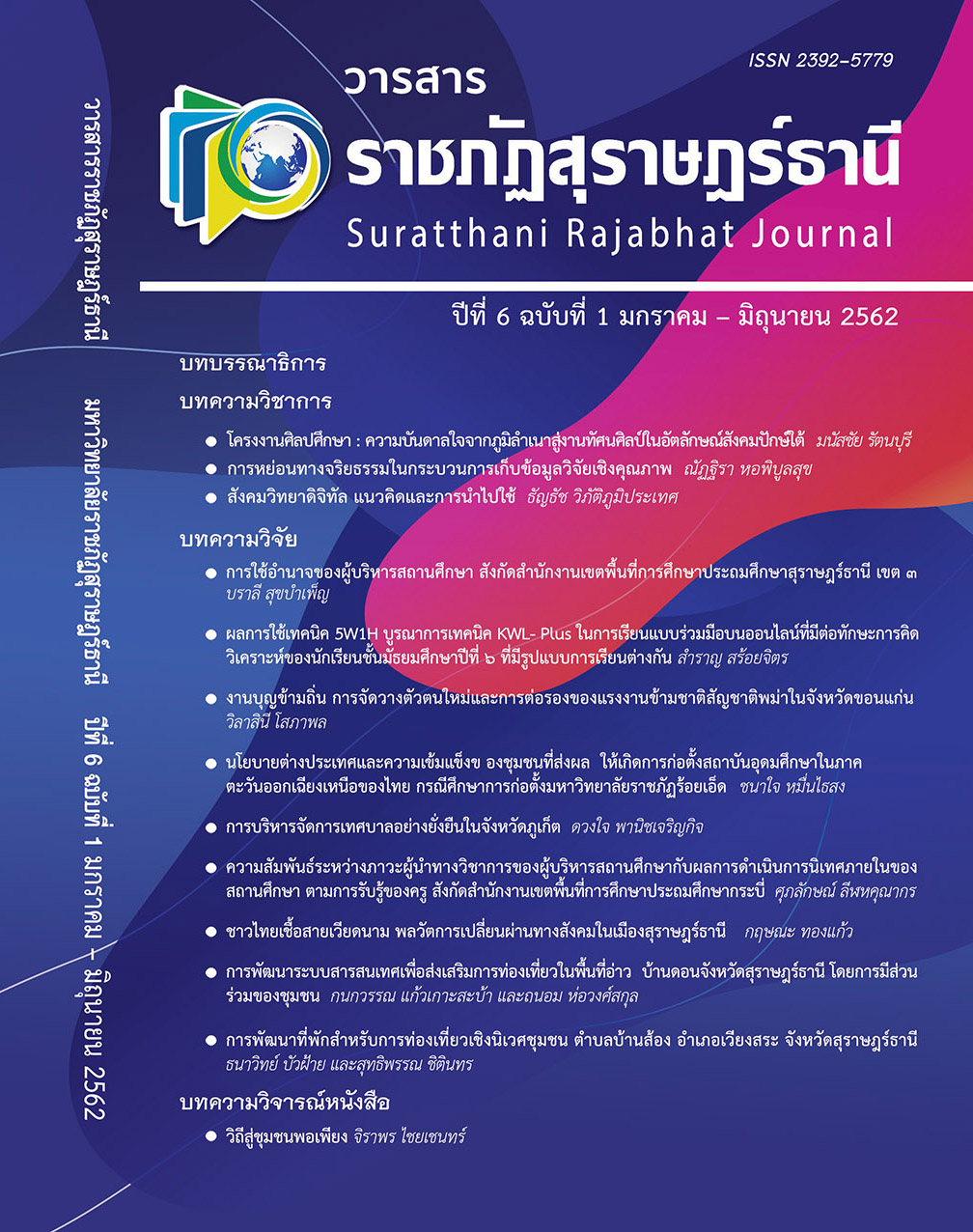The Result of Using 5W1H Questions Technique Integrated with KWL-PLUS Reading Techniques Collaborative Online Learning Upon Analytical Thinking Skill of Mathayomsuksa 6 Students with Different Learning Style
Main Article Content
Abstract
This research aimed to study the different collaborative online learning style using 5W1H questioning technique integrated with KWL-Plus reading technique. It affects analytical thinking skills of Mathayomsuksa 6 (grade 12) students who have a different learning style. The samples group for this study were 124 students of Mathayomsuksa 6 (grade 12) from Prasatwitayakarn School, Prasat district, Surin province, Secondary Educational Service Area 33. The research tools were 4 activities from the Think–Pair–Share collaborative online learning activities on Facebook which use 5W1H questioning technique integrated with KWL-Plus reading technique and the Jigsaw collaborative online learning activities on Facebook which use 5W1H questioning technique integrated with KWL-Plus reading technique. These tools have the highest level of the experts' opinion (X = 4.60, S.D. = 0.54). Moreover, the analytical thinking skill test of 20 items has a difficulty index between 0.31 and 0.85, a discrimination value between 0.20 and 0.78, and content validity at 0.73. The statistical methods for data analysis consisted of arithmetic average, standard deviation, percentage average, and Two-way ANOVA
Research Conclusion
- The results showed that the students who have practiced in different learning styles of Think–Pair–Share collaborative online learning and the Jigsaw collaborative online learning using 5W1H questioning technique integrated with KWL-Plus reading technique activities on Facebook have different analytical thinking skills with the significance level of 0.05.
- The Think–Pair–Share collaborative online learning and the Jigsaw collaborative online learning activities on Facebook using 5W1H questioning technique integrated with KWL-Plus reading technique have different methods. When practiced by students who have a different learning style, they have different analytical thinking skill with the significance level of 0.05.
- The students who have the different learning style when practiced with the different collaborative learning activities methods, have no different the analytical thinking skill with the significance level of 0.05
Article Details
References
Ministry of Education. (2005). การวัดและประเมินผลอิงมาตรฐานการเรียนรู้ตามหลักสูตรการเรียนรู้ กลุ่มสาระการเรียนรู้ภาษาต่างประเทศ [Standards – Based Assessment for English Subject Area Curriculum]. Bangkok : Kurusapa Ladprao Printing Press.
Ministry of Education. (2006). แนวทางการจัดการเรียนรู้เพื่อพัฒนาทักษะการคิดวิเคราะห์ [Learning Management Guidelines for Developing Analytical Thinking Skills]. Bangkok : Bureau of Academic Affairs and Educational Standards.
Nasongkhla, J. (2004). การออกแบบการเรียนการสอนบนเว็บในระบบการเรียนอิเล็กทรอนิกส์ [Web-Based Instruction in E-Learning System]. Bangkok : Faculty of Education, Chulalongkorn University.
Khammani, T. (2004). ศาสตร์การสอน องค์ความรู้เพื่อการจัดกระบวนการเรียนรู้ที่มีประสิทธิภาพ [Teaching Science: Body of Knowledge for Making Effective Learning Process]. Bangkok : Faculty of Education, Chulalongkorn University.
Nonthamand, N. (2011). ผลของการแทรกเทคนิคการตั้งคาถาม 5W1H ในวิดีโอบรรยายออนดีมานด์บนเว็บ 2.0 ที่มีต่อผลสัมฤทธิ์ทางการเรียนและความสามารถในการแก้ปัญหาของนิสิตปริญญาตรี [Effects of an Insertion of 5W1H Questions in Lecture Videos on Demand Via Web 2.0 on Learning Achievement and Problem Solving Ability of Undergraduate Students]. Bangkok : Faculty of Education, Chulalongkorn University.
Charoendee, N. (2007). ผลสัมฤทธิ์ทางการเรียนของนักเรียนที่มีรูปแบบการเรียนต่างกันโดยใช้บทเรียนบนเว็บ วิชาคณิตศาสตร์ประยุกต์ 2 [A Comparison of Learning Achievement of Student Studying Different Learning Style of Web-based Applied Mathematics 2]. Bangkok : Technical Education Technology, King Mongkut’s University of Technology North Bangkok.
Srisaard, B. (1994). การพัฒนาการสอน [Development of Teaching]. Bangkok :
Suweeriyasan.
Office of the Basic Education Commission. (2006). กระทรวงศึกษาธิการ [Ministry of Education]. Bangkok : Ministry of Education.
Office of the Basic Education Commission. (2006). แผนการศึกษาแห่งชาติ พ.ศ. 2545-2559 [National Education Plan Act B.E. 2002 – 2016]. Bangkok : Office of the Education Council.
Ali Reza BaneshiI, Mahnaz Dehghan Tezerjani, and Hasan Mokht Arpour. (2007). Grasha-Richmann college students’ learning styles of classroom participation: role of gender and major. Autho information. Articlenotes.Copyright and License information.
Al-Khateeb. O. S.M., & Idrees. M. W. K. (2010). The impact of using KWL strategy on grate Ten female students’ reading comprehension of religious in Ma’an city. European Journal of Social Sciences. 3(12). 472-489.
Anthony F. Grasta. (1980). Psychology of Adjustment and Competence : An Applied Approach. Cambridge, Massachusetts: Winthrop Publishers Inc.
Barkley, Elizabeth F., Cross K. Patricion and Major Claire Howill. (2005). Collaborative Learning Teachniques (5th ed). San Franciso : John Wiley & Sons.
Carr E. and Ogle. (1987). “K.W.L. Plus A Strategy for Comprehension and Summarization.”Jamal of Reading.30 (April 1987: 626-631.
Driscoll. M. (1997). Defining Internet-Based and Web-Based Training. Performance Improvement. 36(4), April 1997 : 5-9.
Hamidah, Jaafar Sidek and Sarina, Muhamad Noor. (2009). The Social Interaction Learning Styles of Science and Social Science Students. Faculty of BusinessManagement. Universiti Teknologi MARA Perlis.
Rudyard Kipling. (1902). The Kipling method (5W1H). Poem: I have six honest serving men.


